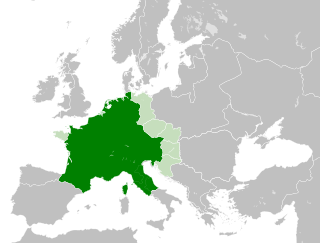
Louis the Pious, also called the Fair and the Debonaire, was King of the Franks and co-emperor with his father, Charlemagne, from 813. He was also King of Aquitaine from 781. As the only surviving son of Charlemagne and Hildegard, he became the sole ruler of the Franks after his father's death in 814, a position that he held until his death except from November 833 to March 834, when he was deposed.

The Carolingian Empire (800–887) was a Frankish-dominated empire in Western and Central Europe during the Early Middle Ages. It was ruled by the Carolingian dynasty, which had ruled as kings of the Franks since 751 and as kings of the Lombards in Italy from 774. In 800, the Frankish king Charlemagne was crowned emperor in Rome by Pope Leo III in an effort to transfer the status of Roman Empire from the Byzantine Empire to Western Europe. The Carolingian Empire is sometimes considered the first phase in the history of the Holy Roman Empire.

Lothair I was a 9th-century Carolingian emperor and king of Italy (818–855) and Middle Francia (843–855).

Adalard of Corbie was the son of Bernard who was the son of Charles Martel and half-brother of Pepin; Charlemagne was his cousin. He is recognised as a saint within the Roman Catholic and Eastern Orthodox Church.
Ermengardeof Hesbaye, probably a member of the Robertian dynasty, was Carolingian empress from 813 and Queen of the Franks from 814 until her death as the wife of the Carolingian emperor Louis the Pious.
Agobard of Lyon was a Spanish-born priest and archbishop of Lyon, during the Carolingian Renaissance. The author of multiple treatises, ranging in subject matter from the iconoclast controversy to Spanish Adoptionism to critiques of the Carolingian royal family, Agobard is best known for his critiques of Jewish religious practices and political power in the Frankish-Carolingian realm. He was succeeded by Amulo of Lyons.
Charles the Child was the King of Aquitaine from October 855 until his death in 866.
Hugh or Hugo (802–844) was the illegitimate son of Charlemagne and his concubine Regina, with whom he had one other son: Bishop Drogo of Metz (801–855). Along with Drogo and his illegitimate half-brother Theodoric, Hugh was tonsured and sent from the palace of Aachen to a monastery in 818 by his father's successor, Louis the Pious, following the revolt of King Bernard of Italy. Hugh rose to become abbot of several abbacies: Saint-Quentin (822/23), Lobbes (836), and Saint-Bertin (836). In 834, he was made imperial archchancellor by his half-brother.

Drogo, also known as Dreux or Drogon, was an illegitimate son of Frankish emperor Charlemagne by the concubine Regina.
Matfrid was the Frankish count of Orléans in the reign of Emperor Louis the Pious. He is usually thought to have been the first of the lineage known to historians as the Matfriede.

Vita Hludovici or Vita Hludovici Imperatoris is an anonymous biography of Louis the Pious, Holy Roman Emperor and King of the Franks from AD 814 to 840.
Thegan of Trier was a Frankish Roman Catholic prelate and the author of Gesta Hludowici imperatoris which is a principal source for the life of the Holy Roman Emperor Louis the Pious, the son and successor of Charlemagne.
Guerin, Garin, Warin, or Werner was the Count of Auvergne, Chalon, Mâcon, Autun, Arles and Duke of Provence, Burgundy, and Toulouse. Guerin established the region against the Saracens from a base of Marseille and fortified Chalon-sur-Saône (834). He took part in many campaigns during the civil wars that marked the reign of Louis the Pious (814–840) and after his death until the Treaty of Verdun (843). The primary sources for his life are charters and chronicles like the Vita Hludovici.
Louis, a Frankish churchman and a member of the Carolingian royal family, was the Abbot of Saint-Denis from 841.
The Hattonids were an important imperial noble family in the first half of the 9th century, during the reigns of the Carolingian kings Charlemagne and Louis the Pious. They lost their position under Louis the German. They were patronised by the emperors and were enfeoffed with benefices on imperial estates. They attended empire-wide councils and were given military commands on the borders to defend the empire from Danish Vikings and Slavs.
Halitgar was a ninth-century bishop of Cambrai. He is known also as an apostle to the Danes, and the writer of a widely known penitential.
Wala was a son of Bernard, son of Charles Martel, and one of the principal advisers of his cousin Charlemagne, of Charlemagne's son Louis the Pious, and of Louis's son Lothair I. He succeeded his brother Adalard as abbot of Corbie and its new daughter foundation, Corvey, in 826 or 827. His feast day is 31 August
Wulfar or Wulfaire was the archbishop of Reims from 812 until his death. He was an important administrator in the Carolingian Empire, both before and during his episcopate, under the emperors Charlemagne and Louis the Pious.
Slavomir was a legendary tribal prince of the Obotrites from 809/810 to 819. In 817, he allied with the Danes and opposed the Franks. In 819, he was dethroned and exiled, but reinstated shortly before his death in 821.
Adalbert was Frankish nobleman with lands scattered throughout the Carolingian Empire. He was one of the most trusted advisors of Emperor Louis the Pious. By 838, he was the count of Metz. He was strongly opposed to the ambition of the emperor's son, Louis the German, for a large kingdom in East Francia. After the elder Louis's death, he supported Emperor Lothar I and it was in the latter's service that he was killed in battle with Louis the German.